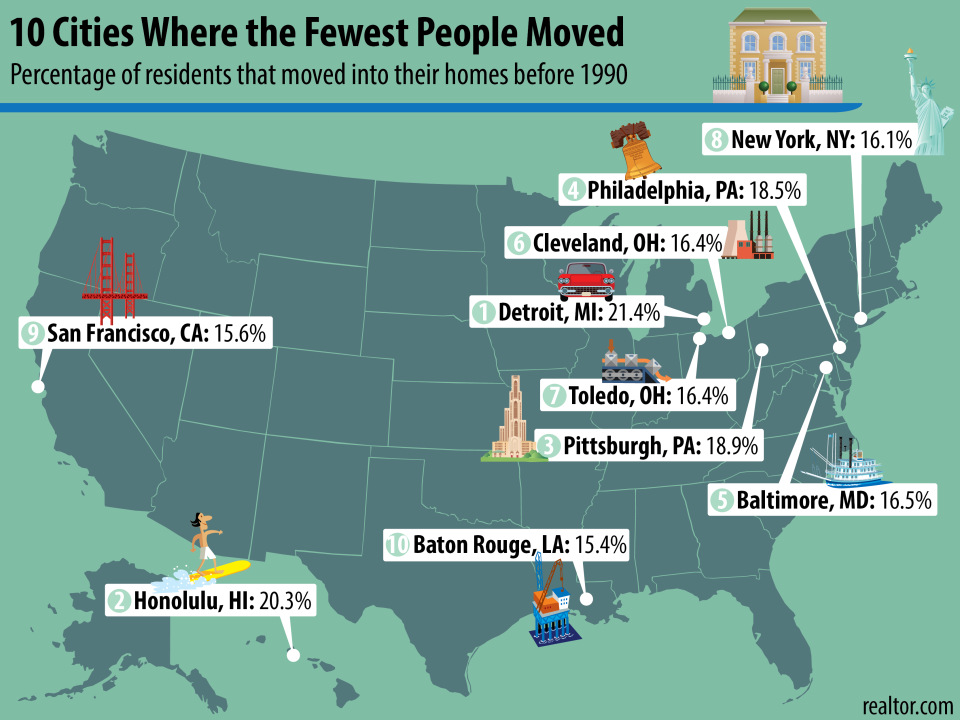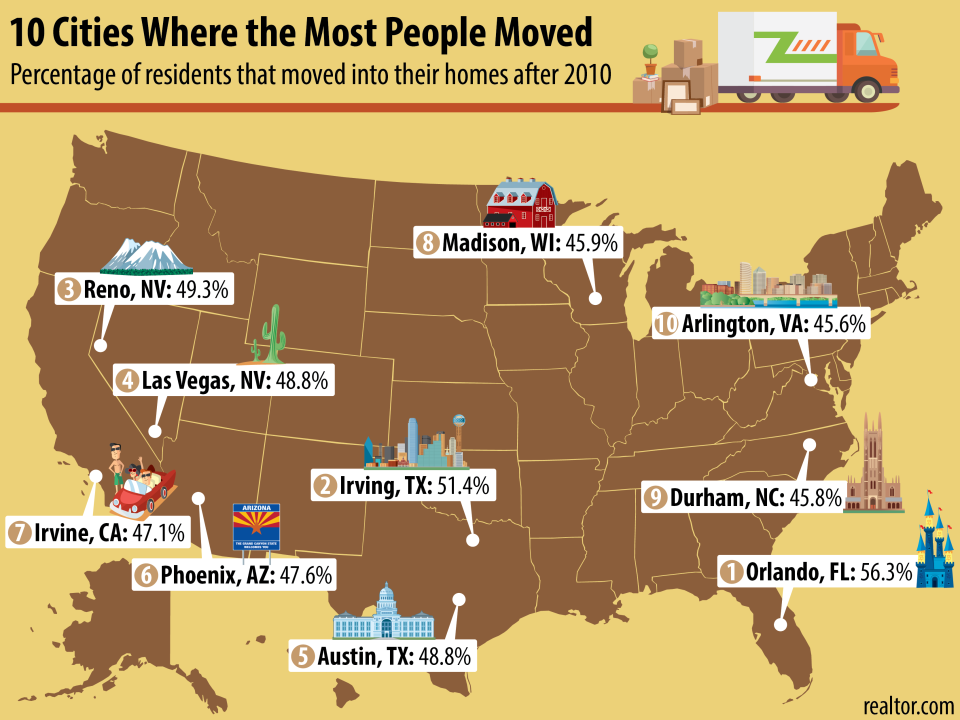Not-So-Mobile America: What Honolulu and Detroit Residents Have in Common
Whether we’re setting out across the country or just changing neighborhoods, upgrading or downsizing—movin’ on up or movin’ on out—the idea of pulling up stakes has always been a core part of the American DNA. Our willingness and eagerness to move is emblematic of our faith in the idea that we can always make a fresh start in a new home.
But actually, we don’t move as often as we used to. Figures for 2015 show that only about 12% of Americans had swapped their address for a new one within the past year. In 1948, when the U.S. Census Bureau first collected moving data, the percentage of those who had moved within the past year was 20%.
We decided to take a look at the U.S. cities that have the most mobile populations—and those where people are most likely to stay in home, sweet home. To gauge which cities had the highest and which had the lowest number of residents moving to new homes—whether across the street or across the country—our data team reviewed the latest U.S. Census Bureau data. For each of the United States’ 100 largest cities, we calculated the percentage of households (both homeowners and renters) that had moved since 2010, to figure out where residents are most mobile.
Then we looked at the places where the largest percentage of households had been in the same home since 1990, to see where folks are staying put.
We found some surprising juxtapositions on our Top 10 “sticking around” list. Do Honolulu and Detroit really have so much in common? Turns out the cities were ranked high on the list for completely different reasons.
“There are two main determining factors whether people move or not,” says Nathalie Williams, a sociology professor from the University of Washington. The good: “The better people feel their lives are going, the less likely they are to move elsewhere.” The bad: Lousy economies can force people to head for greener pastures.
But of course, economic insecurity can also keep people in the same place.
After the housing bust in 2007, migration slowed down, because uncertainties about the job market had made people nervous about changing jobs and deciding to move on. They were less likely to upgrade to a bigger and nicer home. Plenty even found their homes deep underwater, and were unable to sell.
Now that the recession is over, mobility is finally picking up again, says Kenneth Johnson, a demographer at the University of New Hampshire. And jobs lure people, especially younger ones who haven’t put down deep roots, to new centers of employment.
So where are the folks the most and least mobile? The answers just might surprise you.

Detroit: When the going gets tough, the tough stay put
In the mid-20th century, Detroit, our least mobile city, drew thousands of workers, because it was the home of the Big Three automakers. But as the American auto industry lost market share and began to shed workers, the population dwindled. And while young people are streaming out, many longtime residents are staying put. The Census data show that 21.4% of Detroit families moved into their homes before 1990, the highest percentage in our study.
One reason is that owners are simply stuck in their homes.
About one in five Detroit homes is still seriously underwater, with a loan amount that is at least 25% higher than the property’s market value, according to ATTOM Data Solutions, a real estate information company. The median home value in Wayne County, where Detroit is located, is only $149,602, but the median loan amount is $161,965.
“If your house is upside down, you can’t move. You can abandon your house, but there’s no way to sell it,” says Eli Lehrer, president of R Street Institute, a policy research organization. He notes that people receiving government assistance typically have to reapply if they relocate to another state—and might not qualify, or have their benefits reduced.
Many Detroit residents live and shop near hulking vacant buildings that have been abandoned, overtaken by weeds, graffiti, and trash. But as the city recovers, its longtime residents are an integral part of the city’s growth, says Tahirih Ziegler, executive director of Local Initiatives Support Corporation, which promotes safe communities and affordable housing.
“Longtime residents stabilize their communities by mowing their lawns, keeping properties in good condition, investing in their homes. Overall, that’s helping the city stabilize the population,” Ziegler says.
Similar narratives of decline play out in Midwestern cities like Pittsburgh (No. 3), Cleveland (No. 6), and Toledo, OH (No. 7), after the steel industry’s downfall.
The high costs of moving often prevent the poorest folks from relocating, says retired New York University journalism professor William Serrin. Serrin wrote about the fate of a former steel town outside Pittsburgh in his book “Homestead: The Glory and Tragedy of an American Steel Town.”
“When you are 52 years old and have five kids, you don’t just move to Arizona—it’s just not in the cards,” Serrin says.
On the East Coast, Philadelphia (No. 4) and Baltimore (No. 5) are some of the country’s oldest cities. So it’s no surprise to see generations with deep ties to their metros.
Honolulu: Why ever leave?
Blue ocean waters, soft sand, mountains of Spam, and tropical weather all year round—it makes sense that people wouldn’t want to leave Honolulu, right?
But it also may come down to dollars and cents. The median list price of single-family home in this U.S. paradise is a whopping $730,000, according to realtor.com®. So while longtime homeowners stand to profit if they sell, they might not be able to afford another home in this town—or perhaps anywhere in Hawaii.
In addition, established homeowners benefit from the fact that the 50th state has, by far, the lowest property tax rates in the country.
And the unique culture of Hawaii binds people together.
Leonard Kam, 60, was born in Honolulu and runs Alicia’s Market, a general store that sells Chinese-style roast duck alongside Hawaiian poke bowls of marinated raw fish. His parents, who were originally from China, started the store in 1949 in a small wooden hut. Now Kam’s two sons help him develop new recipes. It’s a third-generation business, Kam says with pride.
“Honolulu is a small community. Everybody knows everybody, we are all family,” says his son Chris Kam. “You don’t move to the mainland unless you have to.”
New York and San Francisco: America’s meccas of the stubborn

Once you go BK, you never go back.
Maremagnum/Getty Images
Once a New Yorker, always a New Yorker. Maybe it’s because it’s so hard to find a foothold—or a decent apartment—in this town, just as it is in San Francisco (No. 9). You hang on to what you can get for as long as you can. That’s why, despite skyrocketing home prices and rents, many residents have managed to stay in their homes for decades. And low housing inventories don’t make intercity moves easy.
About 16.1% of New Yorkers and 15.6% of San Franciscans have been living in the same home since 1990, according to Census data. That’s compared with 13% of the population nationally. Yes, gentrification is pricing out longtime residents in some areas, especially renters. But luckily, both cities have rent control or rent stabilization, which keep some renters in their homes.
A certain amount of stubbornness helps too.
Regina Karp, 78, a retired public school teacher, has lived in a rent-controlled apartment on the Upper West Side of Manhattan for 47 years. Her children grew up there and left, her husband passed away, and now she’s living by herself. For two bedrooms, she pays almost $3,000 a month, which she says is her entire pension. Still, she nevertheless refuses to leave.
“This is my apartment. I was born in New York City, I’ve lived here my entire life. All my friends are here. I’m simply not going to live in the middle of a suburb in Jersey,” Karp says.

Orlando: Life beyond Shamu
Outsiders may think of Orlando as the home of Mickey Mouse and poor Shamu, but increasingly, this is the city that leads Florida in job creation. The metro added 50,300 jobs in December, according to the Florida Department of Economic Opportunity.
Health care is one of the fastest-growing local employment sectors: Orlando’s newest asset is a medical research park with a medical school, three major hospitals, and multiple research labs. The city even benefits from the Disney World expansion, including an “Avatar”-themed addition opening in May and a “Star Wars”-themed addition that is in the planning phase.

Orlando sprawl
Arrangements-Photography/iStock
All this economic prosperity means that more people are moving here—and those already established may now have the means to upgrade their living situation.
“Economic development is usually glacial, but it’s been like a volcano erupting in Orlando. The development happened very rapidly,” says Sean Snaith, director of the Institute for Economic Competitiveness with the University of Central Florida in Orlando.
Orlando is trying out different remedies for its infamous sprawl, from bike rentals to commuter rail.
Nevada: A good place to start a business
The low cost of living and business-friendly atmosphere also makes Nevada an appealing place to call home. Reno (No. 3), the self-proclaimed “Biggest Little City in the World” has long been better known as a pauper’s version of Las Vegas. But put all that aside: The place is fast becoming a high-tech manufacturing hub. A few miles east of Reno, Tesla’s Gigafactory manufactures batteries for its electric cars.
“We have no corporate tax, no income tax, a very pro-business government,” says Mike Kazmierski, president of the Economic Development Authority of Western Nevada. That makes it easier for newcomers as well as locals to become entrepreneurs.
Big brother Las Vegas (No. 4), too, is adding people in its many master-planned communities. The high cost of living in Los Angeles and San Diego is pushing Californians to look for greener pastures—or even desert living.
Jacob Orth, a 29-year-old hospitality worker, moved to Vegas from San Jose four years ago. At the time he left, San Jose was the most expensive housing market in the country (it still is). Orth says he cut his living costs by half after the move. And he’s not alone—millennials are flocking to Vegas for its abundant entry-level jobs.
“The big secret about the Las Vegas area is that it’s a lot more family-oriented than people realize. The Strip is kind of like its own little world; once you get outside it, life is pretty normal,” says Orth, who writes about Sin City in his blog, “Jacob’s Life in Vegas.”

Las Vegas
SerrNovik/iStock
Texas’ population boom
It’s hard not to see the appeal of Austin (No. 5): with the booming tech scene, friendly people, great live music, and amazing barbecue, just for starters. No wonder 20-something engineers, boomer corporate hot shots, and even retirees are flocking to the place. And plenty of them live in sweet high-rise apartments that were built over the past decade.
Grandmother Susi Spies moved to Austin two years ago, to be close to her children and their families.
“My children asked me to babysit for them, but I’m too busy having fun [with] food trucks, hiking trails, bat-watching cruises,” says Spies, president of Austin Newcomers, an association that connects new residents with one another and to their new neighborhoods. “It’s an amazing city.”
Texas’ population boom is no secret, but few cities add people as fast as Irving (No. 2), a suburb of Dallas. Home to ExxonMobil, and surrounded by corporation headquarters, like those of AT&T and J.C. Penney, the city’s flourishing job market is powering its exponential growth.
Fast turnover in college towns
Some of America’s most transient cities are college towns. In addition to Austin, there are Irvine, CA (No. 7), Madison, WI (No. 8), and Durham, NC (No. 9). For obvious reasons, incoming students and departing graduates help raise the turnover figures as they move back home or to different parts of the country to start careers.
“College towns are more transient, because new students come every year, and four years later, they are out,” says Realtor Alex Saloutos of First Weber Realtors in Madison. Plus, they tend to move around quite a bit during their tenure. “Students don’t buy homes, they rent.”
The post Not-So-Mobile America: What Honolulu and Detroit Residents Have in Common appeared first on Real Estate News & Advice | realtor.com®.


